SIPs: Refreshing Old Potting Mix:
Extending Life of Soil
As you enter your second garden season in your new SIP you may find yourself in a bit of a quandary, especially if you used a retail potting mix in year one. What should be done with your old potting mix? Is the old soil still usable? Does potting mix need refreshed?
Well I'm happy to report that I've continued to use my same SIP potting mix even after 12 years of use! So yes, it can be re-used for years and years. Just replenish nutrients and maintain structure by following these tips:
- How to Keep Using Old Potting Mix:
- How Long Can Potting Mix Last?
- How to Maintain Old Potting Mix Structure
- How to Restore Volume After Potting Mix Settles
- How to Replenish Nutrients in Old Soil
- Can You Add Liquid Fertilizer to the Water Reservoir?
- Can You Add Compost & Manure to Old Potting Mix?
How Long Can Potting Mix Last?
POTTING MIX LIFESPAN: I've seen many resources indicating that potting mix doesn't take long to break down. After a year or two people may expect to need new mix. Is that true? These SIPs hold a huge volume of soil and retail potting mix is expensive! Well I wish I could answer this question. But unfortunately I'm only 11 years into my testing. My very first SIP was set up in 2011. And I'm still using it. It has the original potting mix from day one. None of it has been removed. So I can only suggest that the mix will last at LEAST a decade if it's well maintained. Keep in mind though, this only applies to the structural viability as a growing medium. After your very first year, most of your nutrients will be gone, especially nitrogen. Read this page which talks specifically about restoring fertility.
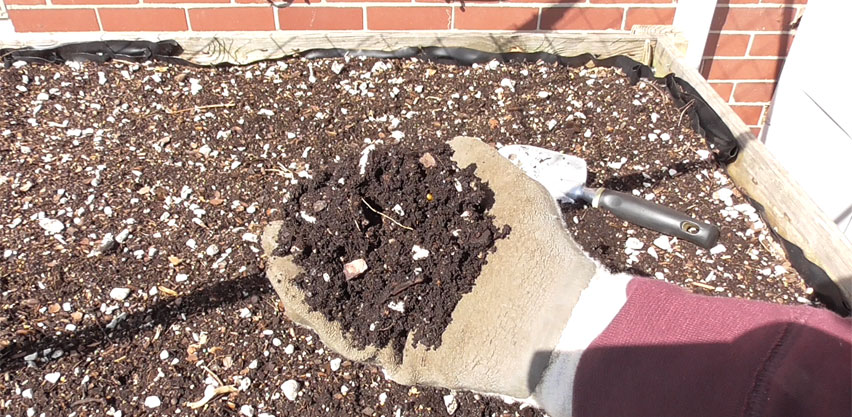
After more than a decade, the old potting mix in this SIP is still performing well!
How to Maintain Old Potting Mix Structure
KEEP YOUR MIX CLEAN: For your SIP potting mix to remain viable after years of use it must retain its water wicking attributes while maintaining good pore spacing for healthy aeration of plant roots. Unlike in-ground garden soils that are mineral based, there is no need for incorporating excessive "organic matter" in the form of plant waste. After each harvest it's best to pull out large plant roots, shaking off the dirt. Compost the roots in a separate location. This is especially helpful if you don't intend to rotate your crops. Removing old root mass, helps to prevent pathogens from building up in the soil.
COMPACTION IS THE ENEMY! Over time, large particles will start to break down leading to compaction. To compensate for this it is good to add components that will improve soil structure as needed. Perlite will boost aeration if the mix seems too moist. Pine bark fines can help to maintain good structure over time. An important note about wood products in potting mix: Nitrogen draft may occur, requiring additional nitrogen supplementation. To minimize this effect, use dark, outer bark pieces (higher in lignin) which tend to break down slower than light inner wood. Look for aged or composted barks as these are more stable resulting in less N draft. If you add these to your old SIP mix, be sure to mix them in very well. In the Spring before planting, you can aerate the soil by fluffing it and smoothing it out with a rake.
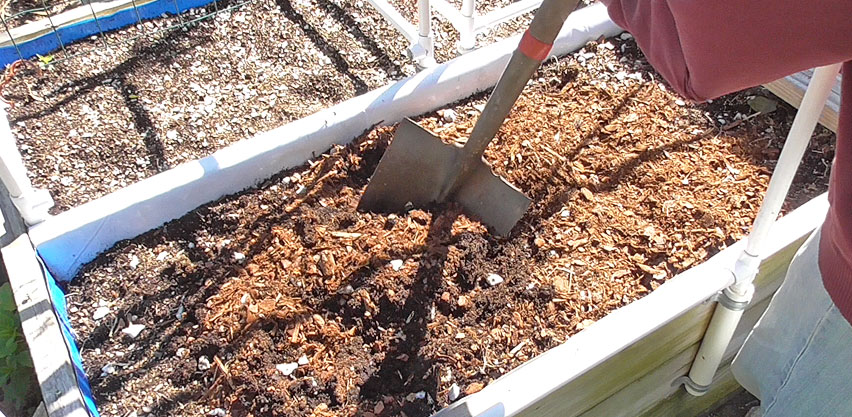
By mixing in fine pine bark mulch, I can keep soil levels topped off in my SIPs.
How to Restore Volume After Potting Mix Settles
TOPPING OFF WITH PEAT MOSS? Adding fresh peat moss is usually not needed. By itself, peat moss is prone to compaction. As potting mixes get old, compaction becomes a growing concern. Of course, if your soil wasn't wicking well in the previous season, topping off your SIP with pure peat moss makes sense. Vermiculite could also be used. Both of these would enhance water absorption.
Adding peat moss is fine if it's included in a complete potting mix which contains perlite and possibly wood products. Tossing in a fresh bag of quality potting mix is an easy way to top off a planter that has settled over the season. If you're on a budget, the pine bark mulch is a great volume expander. Sometimes I'll buy bags that contain fine outer bark pieces. Then I'll just let the bags sit for a whole year and age until the next season.
How to Replenish Nutrients in Old Soil
DRY (GRANULAR) FERTILIZERS: The easiest way to supply most or even all nutrients for the growing season is to simply use dry fertilizers. These might be in powder form, but I prefer slightly larger granular particle sizes. Fertilizers like Espoma Garden-Tone have tiny chunks that release nutrients more slowly throughout the growing season. It is organic and not a true "time release". Even still, I've seen great results over the course of several months, especially when part of it is applied as a fertilizer band.
LIQUID FERTILIZERS: It's possible to sustain your plants through a regimen of only liquid feed throughout the season. However, I prefer not to treat my SIPs like a hydroponic system. Liquid feed is ideal as a supplemental nutrient source. It works great when applied to long-lived crops in the mid-season. At that point, fertilizers may be depleted and liquid fertilizers can keep plants thriving.
It's also good for boosting nutrients in the event of a soil deficiency. Liquid plant food is fast acting, allowing plants to immediately absorb whatever minerals they need. Some gardeners will use foliar applications on plants like tomatoes or peppers at flowering or fruiting time to improve yield.
Can You Add Liquid Fertilizer to the Water Reservoir?
Liquid feeds are best when applied to the leaves (foliar) or to the upper surface of the soil as a root drench. I don't recommend adding fertilizers to the water reservoir directly. There's no advantage to bypassing the root zone of your plants. This especially applies to larger wicking beds. In 5 gallon wicking buckets or SIP totes, it might not matter much. But in large SIP beds, there's no guarantee that the nutrients will diffuse evenly throughout the entire reservoir. Also, you don't know how well the fertilizer will permeate vertically into the upper substrate.
By applying the fertilizer as a root drench, I know the nutrients are reaching my plants' upper feeder roots. I can ensure that the nutrients are evenly distributed to ALL plants. Or I can specially target the plants that I want to focus on (if that's what I'm trying to achieve). In my 4'x8' SIP bed, I've been supplementing my tomatoes within a 2'x2' corner to see how they respond. All of the nutes are applied directly to that small root zone. The plants are loving it!
Ultimately, some of the nutrients will leach into the lower soil and drain into the reservoir. But by starting out with a root drench, you can minimize any losses of nutrients into the overflow drainage.
Can You Add Compost & Manure to Old Potting Mix?
WHAT'S WRONG WITH MANURES & COMPOSTS? If you've seen my original SIP video from many years ago, perhaps you've wondered why I said: "You don't want to use manures. You don't want to use those gross composts that you get in the bag at the store." Some people have been curious. Of course, other people have been completely triggered. I've seen people who overreact, assuming that I'm only an advocate for synthetic fertilizer. They may think I'm opposed to all forms of manure and compost in all situations, but that's simply not true.
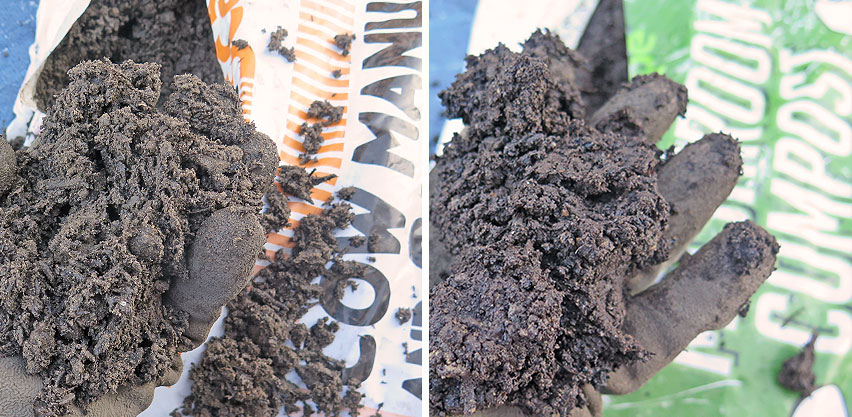
The texture of these bagged manures & composts is silty & sandy. These will not perform well in an SIP.
Although some compost blends are fluffy and well textured, others are absolute garbage. Sure, you could throw them in an in-ground bed and the plants will grow. But a sub-irrigated planter doesn't function in the same way. It is constantly in contact with water. For plants to thrive, you need to strike a good balance between water absorption and aeration. From that perspective, cheap, industrial bags of manure or compost just don't cut it.
BAGGED COMPOSTS / MANURES? To prolong the viability of your SIP potting mix, it's best to replenish nutrients in the form of fertilizers. Organic gardeners are apt to use compost as often as possible. In SIPs, worm castings can be included in small amounts. But using composts in containers can yield unpredictable results. Bagged (retail) compost, humus or manure might have a fine consistency, similar to garden soil. If it contains fine silty particles then this can reduce pore spacing and aeration properties of the mix. That's why topsoil is NEVER recommended.
I would like to point out that this is not a theoretical concern. I've seen real world situations where gardeners' SIP beds have completely failed because of using subpar materials. Note how one gardener described her bad experience:
I ordered a planters mix and had it delivered. It's composed of Compost (though I couldn't see any good black dirt in there), Manure, and top soil. Needless to say, I had ZERO wicking, and even when I top watered nothing grew. By July I did my research and felt stupid on both SIP forums and Garden Forums. I'm currently unloading the dirt from the bed and it's a muddy nightmare from the warm spring snow.
As air gaps get plugged up by ultra fine particles, compaction occurs. And since SIPs are always resting on a perched water table, the few remaining air gaps tend to be saturated with water. This impairs root health, preventing plants from getting the oxygen needed at the root zone. This can lead to a decline in plant growth, or even root rot and death. Even if plants grow ok in the first year, over time the potting medium may break down to the point that it must be replaced.

I've successfully used "Mel's Mix" soil in a bucket SIP with 33% of a woody homemade compost. Only for 1 season though.
HOMEMADE COMPOST? Buying bagged compost is not financially advantageous in large beds anyway, not when compared to buying a bulk organic fertilizer. Of course, homemade composts might work, especially if they are mostly wood based. These tend to have more structure. Larger particle size means improved aeration. I've found though that it's very easy to reserve my compost for conventional beds and perennial plantings. It all gets used, just in a different location.
← SIP Potting Mix Fertilization: Year 1
Fertilizer Application Rates: Containers →

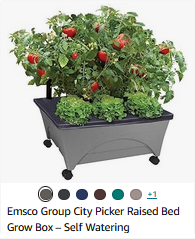

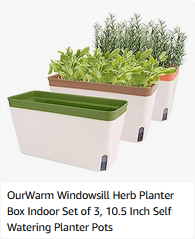

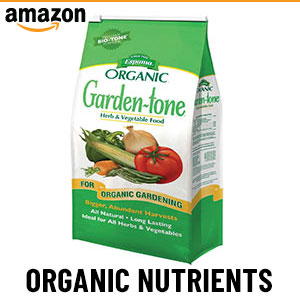
![GARDENERS: Who else would pay money for poop? [Gardening T-Shirt Design]](images/GARDENERS--Who-else-would-pay-money-for-poop_Gardening-Tshirt-th.jpg)
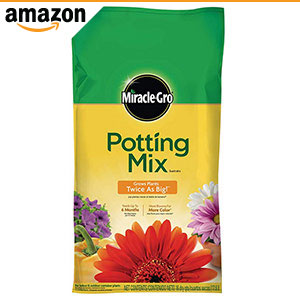
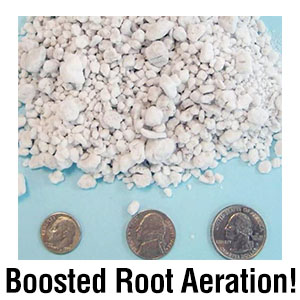
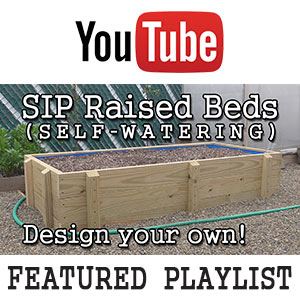
![Friends Don't Let Friends Throw Out Leaves [Gardening T-Shirt Design]](images/Friends-Dont-Let-Friends-Throw-Out-Leaves_Gardening-Tshirt-th.jpg)